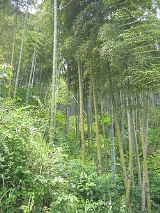
Anji County
Encyclopedia
Anji County is a county in the prefecture-level city
Prefecture-level city
A prefectural level city , prefectural city or prefectural level municipality is an administrative division of the People's Republic of China, ranking below a province and above a county in China's administrative structure. Prefectural level cities form the second level of the administrative...
of Huzhou
Huzhou
Huzhou is a prefecture-level city in northern Zhejiang province of Eastern China. Lying south of the Lake Tai, it borders Jiaxing to the east, Hangzhou to the south, and the provinces of Anhui and Jiangsu to the west and north respectively.-Administration:...
in Zhejiang
Zhejiang
Zhejiang is an eastern coastal province of the People's Republic of China. The word Zhejiang was the old name of the Qiantang River, which passes through Hangzhou, the provincial capital...
, People's Republic of China
People's Republic of China
China , officially the People's Republic of China , is the most populous country in the world, with over 1.3 billion citizens. Located in East Asia, the country covers approximately 9.6 million square kilometres...
, with a population of 450,000. Anji county is well known for its bamboo, containing as it does 60,000 hectares of bamboo groves. It has been designated a pilot county for ecological construction.
Anji is 65 kilometers from Hangzhou. During the 1990s, it took more than two hours to travel to Hangzhou
Hangzhou
Hangzhou , formerly transliterated as Hangchow, is the capital and largest city of Zhejiang Province in Eastern China. Governed as a sub-provincial city, and as of 2010, its entire administrative division or prefecture had a registered population of 8.7 million people...
by bus. Poor transportation isolated Anji from the rest of Zhejiang Province, and for many years its economy remained underdeveloped. From 1997 to 2000, highways were built to Hangzhou and Huzhou, and from 2000 to 2002, highways connecting to National Highway G318 were constructed. The provincial highways within its boundary were also widened. Now the highway system traversing the entire boundary has been completed, and it takes less than three hours to reach Shanghai, Nanjing or Suzhou, and less than one hour to get to Hangzhou and Huzhou. Some of Anji's residents have attempted to take the sustainable development road by developing ecology-friendly agriculture, industry and tourism, and building an ecology-friendly city.
Tianhuangping Pumped Storage Power Station
Tianhuangping Pumped Storage Power Station
The Tianhuangping Pumped Storage Power Station is a pumped-storage power station in Tainhuangping, Anji County of Zhejiang Province, China. The power station has an installed capacity of 1836 MW utilizing 6 x reversible Francis turbines...
is located there.
Ecological Tour
The ecological tour area covers one-tenth of the county's total area. Anji produces 12 million commercial bamboo poles annually, ranking first nationwide. It also has China's largest bamboo nursery. The Anji Bamboo Garden is acknowledged by scholars within and outside China as containing the widest variety of bamboo to be found. It was formerly a bamboo grove research base that combined scientific research with teaching, and has received many foreign experts and scholars and officials from the International Network for Bamboo and RattanInternational Network for Bamboo and Rattan
The International Network for Bamboo and Rattan is an independent intergovernmental organization established in 1997 to develop and promote innovative solutions to poverty and environmental sustainability using bamboo and rattan....
.
At the Longwang (Dragon King) Mountain Nature Reserve, lies the source of the Huangpu River, and the 800-hectare primeval forest there contains numerous flora and fauna under national protection. The Huadong Pumping Storage Power Station, located in the Tianhuangping Scenic Area, is the largest in Asia and second largest worldwide. It is meant to blend in with the surrounding environment, and is a Chinese industrial demonstration project. In 2001, Anji received 1.4 million tourists, earning it 310 million yuan, which made up 6.1 percent of the county's GDP. A feasibility plan recently commenced on the 20-square-kilometer British designed Huxi Ecological Garden. Qian Kunfang, county magistrate, says, "Though ours is a mountainous county, we nevertheless receive large numbers of visitors, either sightseeing or seeking to invest, every day. Anji's mountains, waters and pure air are now valuable commodities."

